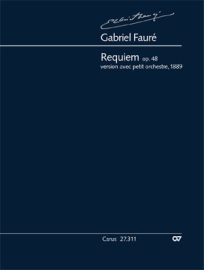Cookies
Wessmans Musikförlag AB använder cookies för att förbättra din upplevelse genom att komma ihåg att du har loggat in. Om du fyller i en blankett använder vi cookies för att komma ihåg uppgifterna till nästa gång. Vi använder cookies från tredje part för att spåra hur du använder vår hemsida, för att till exempel kunna se vilka sidor du besöker och hur länge du är på varje sida. Det hjälper oss att få en bättre förståelse av hur folk använder vår sida och hur de kommer in på den.
Requiem op. 48 Fassung 1889 für kleines Orchester - Partitur
Artikelnummer
2731100
Kategori
Blandad kör
Besättning
Soli SBar, Coro SATB, 2 Cor, 2 Tr, 3 Trb, Timp, Vl, 2 Va, 2 Vc, Cb, Arpa, Org
Kompositör
Fauré Gabriel
790 kr
Version for small orchestra, 1889
The Requiem of Gabriel Faure is now available in two versions: in the symphonic version of 1901 and in the version with small orchestra of 1889. The "symphonic version" of Gabriel Faure's Requiem, published in 1901, was the product of a 13-year compositional process. Starting from the original five-movement form for strings, harp and organ, the composer wrote two additional movements, one after the other, and expanded the instrumentation in various stages for later performances. The present reconstruction of a "version with small orchestra" differs from other such attempts in that for the first time it presents the work not in a mixed version, but rather in the unified form from 1889. This is distinguished from the final version both in musical terms, as well as through the fact that it forgoes the use of flutes, clarinets and bassoons, while employing only two horns instead of four. With a critical Report with information about the source situation and the edition, and containing the individual readings (alternative readings, etc.).
The Requiem of Gabriel Faure is now available in two versions: in the symphonic version of 1901 and in the version with small orchestra of 1889. The "symphonic version" of Gabriel Faure's Requiem, published in 1901, was the product of a 13-year compositional process. Starting from the original five-movement form for strings, harp and organ, the composer wrote two additional movements, one after the other, and expanded the instrumentation in various stages for later performances. The present reconstruction of a "version with small orchestra" differs from other such attempts in that for the first time it presents the work not in a mixed version, but rather in the unified form from 1889. This is distinguished from the final version both in musical terms, as well as through the fact that it forgoes the use of flutes, clarinets and bassoons, while employing only two horns instead of four. With a critical Report with information about the source situation and the edition, and containing the individual readings (alternative readings, etc.).
PDF
Relaterade artiklar (13)
Requiem op. 48 Fassung 1889 für kleines Orchester - Klavierauszug mit Anhang
Körmusik2731102
Kategori
- Blandad kör
Besättning
- Soli SBar, Coro SATB, 2 Cor, 2 Tr, 3 Trb, Timp, Vl, 2 Va, 2 Vc, Cb, Arpa, Org
Requiem op. 48 Fassung 1889 für kleines Orchester - Klavierauszug ohne Anhang
Körmusik2731103
Kategori
- Blandad kör
Besättning
- Soli SBar, Coro SATB, 2 Cor, 2 Tr, 3 Trb, Timp, Vl, 2 Va, 2 Vc, Cb, Arpa, Org
Requiem op. 48 Fassung 1889 für kleines Orchester - Klavierauszug XL im Grossdruckmit Anhang
Körmusik2731104
Kategori
- Blandad kör
Besättning
- Soli SBar, Coro SATB, 2 Cor, 2 Tr, 3 Trb, Timp, Vl, 2 Va, 2 Vc, Cb, Arpa, Org
Requiem op. 48 Fassung 1889 für kleines Orchester - Chorpartitur
Körmusik2731105
Kategori
- Blandad kör
Besättning
- Soli SBar, Coro SATB, 2 Cor, 2 Tr, 3 Trb, Timp, Vl, 2 Va, 2 Vc, Cb, Arpa, Org
Requiem op. 48 Fassung 1889 für kleines Orchester - harminiestimmen
Körmusik2731109
Kategori
- Blandad kör
Besättning
- Soli SBar, Coro SATB, 2 Cor, 2 Tr, 3 Trb, Timp, Vl, 2 Va, 2 Vc, Cb, Arpa, Org
Requiem op. 48 Fassung 1889 für kleines Orchester - violin
Körmusik2731111
Kategori
- Blandad kör
Besättning
- Soli SBar, Coro SATB, 2 Cor, 2 Tr, 3 Trb, Timp, Vl, 2 Va, 2 Vc, Cb, Arpa, Org
Requiem op. 48 Fassung 1889 für kleines Orchester - viola 1
Körmusik2731112
Kategori
- Blandad kör
Besättning
- Soli SBar, Coro SATB, 2 Cor, 2 Tr, 3 Trb, Timp, Vl, 2 Va, 2 Vc, Cb, Arpa, Org
Requiem op. 48 Fassung 1889 für kleines Orchester - viola 2
Körmusik2731113
Kategori
- Blandad kör
Besättning
- Soli SBar, Coro SATB, 2 Cor, 2 Tr, 3 Trb, Timp, Vl, 2 Va, 2 Vc, Cb, Arpa, Org
Requiem op. 48 Fassung 1889 für kleines Orchester - violoncello 1
Körmusik2731114
Kategori
- Blandad kör
Besättning
- Soli SBar, Coro SATB, 2 Cor, 2 Tr, 3 Trb, Timp, Vl, 2 Va, 2 Vc, Cb, Arpa, Org
Requiem op. 48 Fassung 1889 für kleines Orchester - violoncello 2
Körmusik2731115
Kategori
- Blandad kör
Besättning
- Soli SBar, Coro SATB, 2 Cor, 2 Tr, 3 Trb, Timp, Vl, 2 Va, 2 Vc, Cb, Arpa, Org
Requiem op. 48 Fassung 1889 für kleines Orchester - kontrabas
Körmusik2731116
Kategori
- Blandad kör
Besättning
- Soli SBar, Coro SATB, 2 Cor, 2 Tr, 3 Trb, Timp, Vl, 2 Va, 2 Vc, Cb, Arpa, Org
Requiem op. 48 Fassung 1889 für kleines Orchester - komplettes Orchestermaterial
Körmusik2731119
Besättning
- Soli SBar, Coro SATB, 2 Cor, 2 Tr, 3 Trb, Timp, Vl, 2 Va, 2 Vc, Cb, Arpa, Org
Requiem op. 48 Fassung 1889 für kleines Orchester - Orgel
Körmusik2731149
Kategori
- Blandad kör
Besättning
- Soli SBar, Coro SATB, 2 Cor, 2 Tr, 3 Trb, Timp, Vl, 2 Va, 2 Vc, Cb, Arpa, Org
